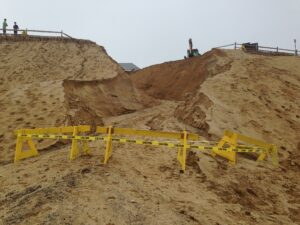WELLFLEET — At the Beachcomber here, as at many other Outer Cape summer spots, the menus are set, the merch is unpacked, the live music is booked, and the countdown to opening day has begun.

This restaurant publicizes that day heavily on social media, where it recently asked its 49,000 Facebook followers what they are looking forward to most as the season kicks off. Many cited the steamers, the tropical Goombay Smash, and the vibe of this bar perched on a bluff overlooking the Atlantic.
But one patron posted hopes for something rarer, that special feeling one gets upon drawing near and finding “the lot is still open.”
Finding a parking spot at the popular restaurant and bar at Cahoon Hollow Beach is a challenge that has gotten harder as erosion carves out sections of the bluff each year.
The town owns the sandy parking area between the edge of the bluff and the restaurant and, until 2019, it provided parking for those using the 160-foot-wide stretch of beach below.
“We used to park about 40 cars in front of the building,” said Suzanne Grout Thomas, Wellfleet’s beach director. “Half of it fell into the ocean during the winter of 2015 to 2016.” Then there was the widely reported blowout in August 2017, when a car plunged down into the bluff as it collapsed during a torrential rainstorm. Similar weather in August 2018 caused more losses. The number of parking spaces in the town-owned section dropped to 20.
“It was apparent we were losing money to have paid parking there because of all the staff and other costs,” Grout Thomas said.
That’s when the town signed an agreement to lease its part of the lot to Beachcomber owner Todd LeBart for $50,000 per season. LeBart must provide portable bathroom facilities that can be used by beachgoers and must handle trash removal as well, Grout Thomas said.
Dan Murray, the Beachcomber’s general manager, said the lease and other expenses related to that front parking area total about $100,000 per year. It has turned out to be a profitable deal for the town. The town’s gross revenue for the final summer of overseeing the lot had been just $37,000, according to Murray.
The restaurant uses the front lot area for employee parking, Murray said, so cars can be tightly packed there. They charge $30 per vehicle for the 90 spaces of customer parking between the restaurant and the road.
That $30 comes with a voucher that can pay for food or Beachcomber merch. “Anything but alcohol,” Murray said. The idea is to encourage people who plan to go to the restaurant to park there rather than catering to those simply using the beach.
“Those spots are pretty much full every day,” he said.
The Beachcomber used to lease the Funk Bus to deliver patrons from other parking lots to the restaurant. They stopped doing it during the pandemic, Murray said, and saw that “people were still finding a way to get here.” According to Raphael Richter, president and CEO of Cape Destinations, his Funk Bus continues to be booked by groups from all over Cape Cod heading to the Beachcomber.
Police have made it clear they don’t want a line of cars waiting to enter the parking lot, Murray said. The town has designated an area for dropoffs, and the Beachcomber pays for a police detail on weekends to keep things moving smoothly on Ocean View Drive outside the lot. “For the last two or three years, it’s been great,” Murray said. “There haven’t been many issues at all.”
Those two years coincide with the time since the Seashore decided to prohibit drinking on Cahoon Hollow Beach, a rule the Wellfleet Police Dept. had called for and helps enforce.
Meanwhile erosion of the bluff has continued.
According to Mark Borrelli, a coastal geologist at the Center for Coastal Studies, erosion on the Atlantic side of the Outer Cape averages three to four feet per year. “The thing to remember about the back side is that it’s incredibly dynamic,” Borrelli said this week. “You can have a few years without erosion, then you can lose 20 feet in one storm.” While you cannot gauge exactly how much time it will take, you can count on the fact that erosion is inevitable, he said.
With the area between the building and the bluff shrinking, LeBart’s plan is to expand parking behind the Beachcomber.
He secured a go-ahead from the Wellfleet Historical Commission on May 7 to demolish the old outbuilding that sits behind the restaurant and houses employees. He’ll use its former location to add parking spots — how many has not yet been determined. LeBart plans to construct a new building for employees on the west side of the property.
During the historical commission’s discussion, members agreed that while the outbuilding is more than 75 years old, it has no historic value. Architect Peter MacDonald, representing LeBart at the meeting, said the building “is near the end of its functional life.”
The historic value lies in the Beachcomber building, which was constructed in 1872 as one of nine lifesaving stations built by the federal government on the Outer Cape. As the Independent has reported, Russell Gallagher purchased the property in 1953 and converted the lifesaving station into an inn that he called the Beachcomber.
LeBart and Hugh Dunbar bought the property in 1978 and opened the popular restaurant and nightclub found there today.
The changes planned by LeBart didn’t happen in time to improve parking conditions for the current season, however. Opening day at the Beachcomber this year is Thursday, May 22.
“When they open, it’s officially the beginning of summer for everybody,” Grout Thomas said.



